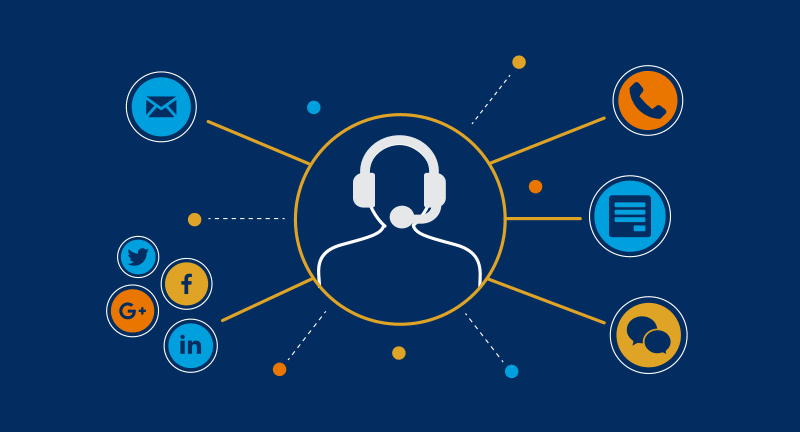Most businesses of any size provide an IT help desk to support their personnel and other internal users of computers, software, and networks. These internal help desks frequently provide IT support for the company’s networking, hardware, and software products.
Technology vendors also provide customer help desk support through customer service help desks. These services are crucial to technology suppliers’ efforts to increase client satisfaction. They typically use CRM (customer relationship management) solutions. This article contains all the information you need to know about the help desk.
What is a Help Desk?
A help desk is a person, group, department inside an organization, or outside service that an IT user contacts for support. A help desk could be a physical workstation where a support representative takes phone calls. It might also be a global organization that takes both spoken and written requests for assistance. Support personnel typically contract out the help desk position.
The expression frequently describes centralized user support provided by an organization. A site where customers can contact to place purchases, track shipments, receive assistance with things, etc., is referred to as a call center in a similar manner.
What is a Help Desk’s Purpose?
A help desk can be as basic as a phone number and one person who can deal with customer issues immediately. Because of the poor scalability of this approach, more sophisticated help desks have support teams of customer care specialists who do some or all of the following tasks:
#1. Acceptance of a help request.
The help desk personnel responds in real-time to clients’ or authorized users’ queries via email, phone, or messaging applications.
#2. Making Tickets
Staff workers utilize help desk software to create help desk tickets that track client support. When a client contact cannot be immediately resolved, help desk staff use the ticketing system to guarantee that customer requests are promptly addressed.
#3. Ticket Administration
Help tickets are routed to the right help desk by a person or piece of software. Service inquiries are forwarded to the appropriate service teams via help desk ticketing software.
#4. Response
Employees resolve problems and respond to client inquiries contained in help desk tickets.
#5. Escalation
Forward the ticket to another team member or take it to the next level if the customer support agent cannot resolve the issue. A complaint may be forwarded only after the service desk has exhausted all internal options to address a client’s issue.
Help Desk Example
The size of the client’s company, how the software is implemented, and how simple it is to access the source code are common factors that categorize the help desk. Keep these things in mind as you search for the appropriate service desk. The five primary types of help desk examples that are now accessible are explained as follows:
#1. Web Help Desk
This program also goes by the label “software as a service.” It is cloud-deployed, and all essential customer service history and data are kept on the host’s servers. Businesses can choose between monthly and yearly subscriptions. These contracts often include maintenance, upgrades, and data storage for backups as part of their technical services.
Downloading the program or logging into their accounts on the vendor’s website will get them to the help desk. The vendor handles technical assistance. Because help desk software requires minimal upkeep, the application has a low recurring cost. This software is typically used by small and medium-sized organizations (SMEs), which frequently lack a maintenance team. Even though this is the case, it’s important to remember that this software is not only for SMEs. Large firms frequently modify it to handle more tickets and users so that it may be utilized throughout their entire enterprise.
However, security and privacy issues might arise because the vendor’s servers are where they maintain clients’ data. Businesses should ensure the web help desk provider they select has robust security and values privacy while searching for reliable service. Another item to consider is the assistance desk. Some may view this as a disadvantage for obvious financial reasons. Still, it allows clients to transfer to a better help desk without worrying about losing money if the software doesn’t meet their expectations. This motivates companies to provide their best products and services to customers to retain them.
#2. On-Site Help Desk
The customer purchased this help desk and set it up on their computers. The consumer keeps the system secure, up to date, and backed up after purchasing the program. If the company hosting the help desk has a lax security system, sensitive data and client information may be in danger. However, there are some contracts where the seller receives an additional payment for maintenance. Because they are intimately familiar with the company’s technical operations, the IT staff can ensure that the software fits into the business without interfering with the current infrastructure. An on-site support desk is a pricey but incredibly flexible investment. Having an on-site technical support crew could be necessary, which also explains why it’s often made for larger businesses.
#3. Business Help Desk
This help desk meets both internal and external clients’ requests for support. It must support the business’s customers and employees so that the former are kept satisfied and the latter’s productivity is not hampered. The enterprise help desk can comprise various flexible components, including account administration, service request fulfillment, and survey management. It is often tailored to meet the procedures of a company or specialized for a certain business sector. An internal help desk can be useful for companies wishing to aid their customers while fostering better relationships and communication amongst divisions.
Help Desk Ticketing System
The selection of a help desk ticketing system might be challenging.
With so many features and selections to think about, it’s simple to become sidetracked and overloaded. It is simpler for everyone to stay on track and eventually have access to the resources they need to fulfill their responsibilities when the optimal system selection procedure is carried out in stages.
The best questions to ask and some other suggestions are provided below to assist you in selecting the best support ticket system for your business.
What is a Ticketing System for a Help Desk?
Client complaints are tracked by software known as a help desk ticketing system so that your support team can respond to them immediately. It gives a team the practical tools to complete daily duties, like helping clients and collaborating on projects.
Ideally, your help desk would act as your support team’s command post or nerve center. It gives your team the tools to carry out their responsibilities, from responding to support queries to collaborating and producing only satisfied customers.
Signs That Suggest Buying a Help Desk Ticketing System
If your daily efforts on a support team are not converting into a pleasurable customer and employee experience, it may be time to consider transitioning to a help desk.
Everyone in this field works extremely hard. However, when there is a genuine mismatch between a company’s objectives and a support team’s ability to deliver top-notch customer care, it could lead to a high employee turnover rate and disgruntled customers.
The majority of small support groups start with a simple, cost-effective approach, such as an email distribution list. Your firm appears to be running smoothly until it begins to grow. With only one help request unanswered, you risk losing a valuable customer’s trust.
The best ticketing programs for help desks
If you’ve decided it’s time for your team to upgrade to a help desk, here are the top ticketing systems to include on your shortlist.
#1. Zendesk
Your customer care representatives can engage with consumers using all channels, including email, messaging, social media, phone, bots, and community forums, thanks to Zendesk. In addition to increasing customer satisfaction, Zendesk ticketing software is a dream for support employees who acquire a deep insight into the entire customer experience, enabling them to stop seeking for information and start assisting clients.
Additionally, managers and admins can easily observe how their team is functioning thanks to the centralized hub’s pre-built dashboards and customer data. Data from these dashboards and reports can be used by managers to more readily spot opportunities to boost efficiency through resource planning, customer request prioritization, ticket workflow enhancement, and other techniques.
#2. Zoho Desk
Smaller customer service teams looking for a platform to grow on might have a look at Zoho Desk. However, Zoho’s CRM supports businesses of all sizes and industries. Many Zoho users find Zoho Desk very beneficial because it easily integrates with other Zoho products. Implementing and using Zoho Desk will be comfortable for you if you have used previous Zoho products.
#3. Assist Scout
The help desk ticketing system for Help Scout is completely functional, just like HappyFox. Like HappyFox, Help Scout can support large teams of more than 500 users. Their customer includes several modern businesses in the recruiting and technology areas. Even for small teams that demand powerful, flexible ticket management systems, Help Scout might still be a great choice.
What Purposes does Help Desk Software Serve?
Help desk software automates essential operations to improve the responsiveness and output of support staff. The core of many help desk solutions is “ticketing.” Whatever method your customer chooses to give you a request will be placed into a digital ticket format with all the relevant details. A brief description of the request or issue, the customer ID, the moment it was reported, the communication method employed, and the service person assigned the task are all included in this.
When choosing a product, you should give this a lot of thought because a system’s handling of these tickets sets it apart from other help desk solutions. Social media interfaces in some help desk software, such as Freshdesk or Zendesk for Service, allow questions and requests posted on social networking platforms to be converted into tickets. This capability might not be essential for a company that uses an internal IT service platform, but it might be for one that serves a substantial customer base.
What Ticketing Software for the Help Desk Is Best?
Most issues are reported to the support desk as “tickets,” as was already mentioned. These start with a list of the salient features of each support request and the filer’s contact information, and they progress from there. Every discussion regarding a specific issue is recorded in the ticket, along with the support agent’s responses and details about how the issue was ultimately resolved. There is yet more to the story. You might have information to contribute about upsells, surveys, or even purchases if you’ve integrated your help desk with your sales or marketing technology solutions.
Help Desk as a Service
Here are some immediate benefits of the best help desk software.
#1. Increased Output
Establish ticket distribution policies so your agents can handle problems as soon as tickets arrive.
#2. Automate Recurring Actions
Utilize SLAs, processes, and macros to accomplish tasks swiftly and notify stakeholders.
#3. Obtain current insights
To track and respond, use pre-built reports or build your own using specific metrics. Obtain traffic data in real-time from the Zoho Desk corporate office and dashboards.
#4. Monitor customer satisfaction.
After every interaction, gauge customer satisfaction to determine how well your agents are performing and to turn a dissatisfied customer into a happy one.
#5. Upgrading Self-Service
Create a bilingual help site with a knowledge base loaded with FAQs and how-to articles, a sizable user community, and discussion forums.
Conclusion
It should be clear by this point that several factors should be considered when selecting a help desk. Take a thorough look at these procedures first to ensure that the capabilities for producing, routing, and closing tickets perform as your organization requires. How does the system support your help desk employees and communicate with your users or clients?
Related Articles
- TICKET MANAGEMENT SYSTEMS: Best Free and Paid Options In 2023
- WORK TICKET: Meaning, Template & How it Works
- 33 Best Event Management Software and Tools In 2023
- TICKETING SYSTEM: 17+ Best Ticketing Systems in the UK (+ Free Options)
- Best Customer Experience Management Software in 2023






